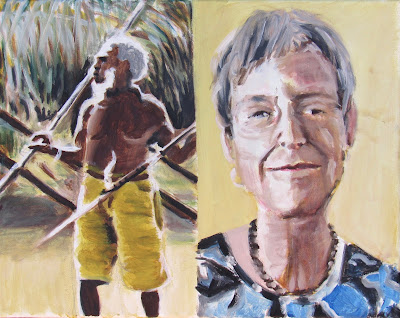Võ Vân Ánh (or Vanessa Vo) is a California based Vietnamese musician best known for her work on the đàn tranh zither. [Wikipedia] After some considerations I opted to use an image of her playing the đàn tranh zither to illustrate a Cai Luong, an instrumental played on a đàn tranh zither. Cai Luong is the most popular genre within the Vong Cô form in traditional Vietnamese folk music. The recording in the Top 100 comes from the album Music of North and South Vietnam: Sung Poetry of the North, Theater Music of the South which was recorded by Stephen Addiss and released by Folkways in 1971. Stephen Addiss is a Professor of Humanities and Art at the University of Richmond in Virginia. His art is greatly influenced by Eastern Zen painting and among books he published is The Art of Zen. [1989] Lacking an image of the performer in the liner notes (no name either, the only information given is that it was performed by a woman) it seemed that a portrait of Addiss would make most sense. While learning about Addiss via Google I wasn't inspired though and kept on searching for an alternative, and settled on this specific image of Vo. I had difficulty in capturing her likeness, which is unusual, so I kept trying, and trying, and trying. Gradually what I perceived as her essence announced itself on the paper. Cai Luong is number 92 in the Top 100 of 2020.

Jean-Pierre Estival/Asurini et Arara (cover)
The next two paintings I completed for the Top 100 2021 pair two European anthropologists with their exotically themed subjects. The word exotic is cringe worthy as it assumes white Eurocentric western culture as norm and different realities as other. The anthropologists, or ethnologists, or musicologists who have been recording the bulk of the Top 100 2021 materials are often musicians themselves but as musician it would be very unlikely tor them to enter the list. Jean-Pierre Estival, who recorded the Brazilian Asurini do Trocara, apparently plays the trombone. He is coupled with an individual from a group depicted on the cover of Brésil: Asurini et Arara. [Ocora, 1995] The Asurini used to roam about stark naked but when Estival recorded them and took the pictures in the late 1980s they were wearing baseball caps and soccer shirts (among other modern dresses.) The Eipo people of West Papua (the Indonesian side, formerly Irian Jaya) still go around without clothes but they did give up their cannibal ways. Paired with the German musicologist Prof. Dr. Arthur Simon is the same Eipo individual I used to illustrate the same Dit song in last year's list. The recording was originally part of an enormous research project and 6-CD set Musik aus dem Bergland west-Neuguineas, Irian Jaya. The CD was released in 1993 but the recordings were made in 1976.
 |
| Eipo woman/Arthur Simon |









